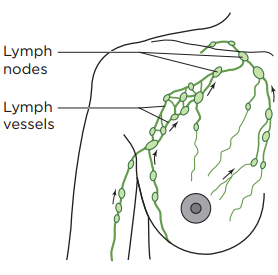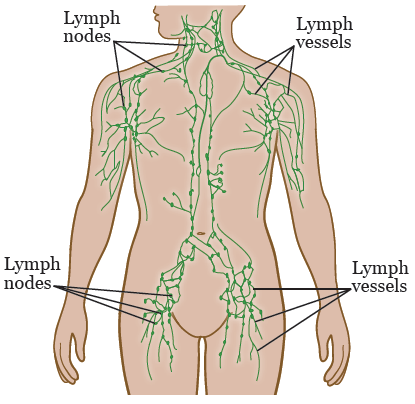This information explains your lymphatic (lim-FA-tik) mapping procedure at MSK.
You may have this procedure if you have breast cancer or melanoma (a type of skin cancer). It will help your doctor see if cancer cells have spread beyond the tumor to your lymph nodes.
About your lymphatic system and lymph node locations in your body

Your lymphatic system has 2 main jobs:
- It helps fight infection.
- It helps drain fluid from areas of your body.
Your lymphatic system is made up of lymph nodes, lymphatic vessels, and lymphatic fluid (see Figures 1 and 2).
-
Lymph nodes are small, bean-shaped glands found along your lymphatic vessels. Lymph nodes filter your lymphatic fluid, taking out bacteria, viruses, cancer cells, and other waste products.
- A sentinel (SEN-tih-nul) lymph node is the first lymph node that cancer cells often spread to. This means it’s the first lymph node a tumor drains into. Sometimes, there can be more than 1 sentinel lymph node that a tumor drains into. A sentinel lymph node is also called a sentinel node.
- Lymphatic vessels are tiny tubes (like your blood vessels) that carry lymphatic fluid to and from your lymph nodes.
- Lymphatic fluid is the clear fluid that travels through your lymphatic system. It carries cells that help fight infections and other diseases.

About your lymphatic mapping procedure
Lymphatic mapping is a procedure where radioactive liquid is injected under your skin near the site of the tumor. The radioactive liquid travels in your lymphatic fluid and creates a “map” of your lymphatic system. This map shows where your sentinel lymph node(s) are located. It does not show whether cancer cells have spread to your sentinel lymph node(s).
Lymphatic mapping often takes about 1 to 2 hours. Check your appointment reminder for where to go for your mapping procedure.
The day of your lymphatic mapping procedure
During your mapping procedure, you will lie in a reclining chair for about 20 minutes. A healthcare provider will give you an injection (shot) of a radioactive liquid called Tc-99m.
They will inject a small amount of the radioactive liquid under your skin near the site of the tumor. This may be the area around your breast, axilla (armpit), or thigh, depending on the kind of cancer you have. You can feel stinging or burning during the injection.
After the injection, you will massage (gently rub) the area of the injection site for 10 minutes. This will help the radioactive liquid travel in your lymphatic fluid to your sentinel lymph node(s).
Then, a technologist will measure the radioactivity from the radioactive liquid that was injected in your body. This will show which lymph node(s) absorbed the radioactive liquid and how much of the liquid was absorbed. The lymph node(s) that absorb the most radioactive liquid are the sentinel lymph node(s).
There are 2 ways to measure radioactivity:
- Using a small handheld device called a Neoprobe®.
- Having a nuclear medicine scan. This is an imaging scan that’s done using a larger machine you lie down on. Read the section “Nuclear medicine scan” for more information.
Both ways work well to measure radioactivity. Your healthcare provider will tell you what to expect.
Nuclear medicine scan
If you’re having a nuclear medicine scan after your injection, your technologist will take you to the scanning room. You will lie on a table while the technologist takes pictures.
Each picture takes about 2 minutes to complete, and you must lie very still during this time. You may find it hard to lie still in 1 position for 2 minutes. If you feel uncomfortable, ask your technologist to count down the time for you. The scan will take about 10 minutes.
The pictures will show the flow of the radioactive liquid. They will also show which lymph nodes absorbed the liquid. This creates a “map” of your lymphatic system. Your surgeon will use this map to find your sentinel lymph node(s).
After your lymphatic mapping procedure
Some people may have another procedure the same day as their mapping procedure. It’s called a sentinel lymph node biopsy. During the biopsy, your surgeon will use the map created from your mapping procedure to find your sentinel lymph node(s). They will take out your sentinel lymph node(s) and send them to a lab to be checked for cancer cells.
If you’re having the biopsy on the same day, a staff member will bring you to the biopsy procedure room.
If you are not having the biopsy on the same day, you will go home after your mapping procedure.
Radiation safety
After your mapping procedure, there will be a very small amount of radiation coming from your body. The amount is so small you do not need to follow any radiation precautions (safety measures).
This means it’s safe to be around other people right after your mapping procedure, including pregnant people and children. You can spend time near others, and can kiss, hug, hold, and touch them. You can also go back to doing your normal activities right away.
Some security equipment (such as at airports or outside tunnels) can detect (find) very small amounts of radiation. A staff member will give you a wallet card that says you had radioactive medicine. This card says you may give off small amounts of radiation for up to 3 days after your procedure. Show this card to law enforcement if they stop you at a checkpoint.
Stop breastfeeding for 24 hours
Stop breastfeeding for 24 hours (1 day) after your mapping procedure. You can keep pumping your milk, but do not feed it to your baby. Throw it away. After 24 hours, you can start breastfeeding again.
If you have any questions about radiation safety, call 212-639-7391 Monday through Friday, from to